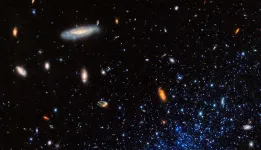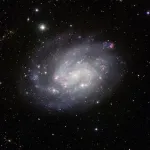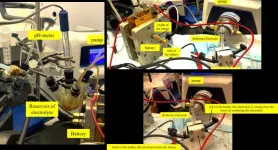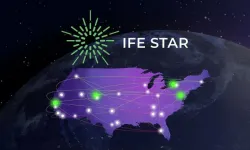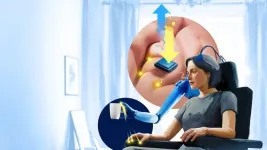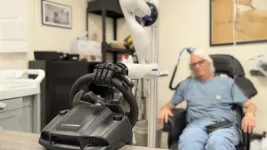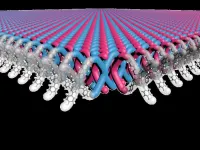(Press-News.org) Leo P, a small galaxy and a distant neighbor of the Milky Way, is lighting the way for astronomers to better understand star formation and how a galaxy grows.
In a study published in the Astrophysical Journal, a team of researchers led by Kristen McQuinn, a scientist at the Space Telescope Science Institute and an associate professor in the Department of Physics and Astronomy at the Rutgers University-New Brunswick School of Arts and Sciences, has reported finding that Leo P “reignited,” reactivating during a significant period on the timeline of the universe, producing stars when many other small galaxies didn’t.
By studying galaxies early in their formation and in different environments, astronomers said they may gain a deeper understanding of the universe's origins and the fundamental processes that shape it.
McQuinn and other members of the research team studied Leo P through NASA’s James Webb Space Telescope, a space-based apparatus that features a large, segmented mirror and an expansive sunshield, both of which enable it to capture detailed images of distant celestial objects.
Leo P, a dwarf galaxy some 5.3 million light years from Earth, was discovered by McQuinn and other scientists in 2013. The celestial structure is far enough away from the Local Group, a clump of galaxies straddling the Milky Way, to be its neighbor without being affected by the gravitational fields of larger star systems.
The galaxy, located in the constellation Leo, is about the same size as a star cluster within the Milky Way and is about the same age as the Milky Way. The “P” in Leo P refers to “pristine,” because the galaxy has so few chemical elements beside hydrogen and helium.
“Leo P provides a unique laboratory to explore the early evolution of a low-mass galaxy in detail,” said McQuinn, who also is the mission head for the Science Operations Center for the Nancy Grace Roman Space Telescope at the Space Telescope Science Institute in Baltimore.
The team started by looking deeply into the past. Since the stars detected by the team with the telescope are about 13 billion years old, they can serve as “fossil records” of star formation that occurred at earlier times. “Essentially, instead of studying the stars in-situ [in their original positions] as they are forming in the early universe, we study the stars that have survived over cosmic history and use their present-day properties to infer what was occurring at earlier times,” McQuinn said.
The team found that Leo P formed stars early on but then stopped making them for a few billion years. This stoppage happened during a period known as the Epoch of Reionization. It took a few billion years after the epoch for the galaxy to reignite and start forming new stars.
“We have a measurement like this for only three other galaxies – all isolated from the Milky Way – and they all show a similar pattern,” McQuinn said.
Observations of the dwarf galaxies within the Local Group, however, show that, in contrast, star production disappeared during this period.
The Epoch, regarded by astronomers as a significant period in the history of the universe, occurred between about 150 million and one billion years after the Big Bang. It was during this period that the first stars and galaxies formed.
The contrast between the star production of the dwarf galaxies provides compelling evidence that it isn’t just the mass of a galaxy at the time of reionization that determines whether it will be quenched, McQuinn said. Its environment – meaning whether it is isolated or functioning as a satellite of a larger system – is an important factor.
McQuinn said the observations will help pin down not only when little galaxies formed their stars, but how the reionization of the universe may have impacted how small structures form.
“If the trend holds, it provides insights on the growth of low-mass structures that is not only a fundamental constraint for structure formation but a benchmark for cosmological simulations,” she said.
The researchers also found that Leo P is metal-poor, possessing 3% of the sun’s metallicity. This means that the stars of the dwarf galaxy contain 30 times fewer heavy elements than the sun, which makes Leo P similar to the primordial galaxies of the early universe.
Knowledge gleaned from these observations will help astronomers piece together the timeline of cosmic events, understand how small structures evolved over billions of years and learn about the processes that led to the creation of stars, McQuinn said.
Other scientists from Rutgers on the study included Alyson Brooks, an associate professor; Roger Cohen, a postdoctoral associate; and Max Newman, a doctoral student, all with the Department of Physics and Astronomy.
END
This tiny galaxy is answering some big questions
Rutgers-led research using the Webb Telescope reveals patterns of star formation in Leo P
2025-01-16
ELSE PRESS RELEASES FROM THIS DATE:
Large and small galaxies may grow in ways more similar than expected
2025-01-16
A team of astronomers led by University of Arizona researcher Catherine Fielder has obtained the most detailed images of a small galaxy and its surroundings, revealing features typically associated with much larger galaxies. The observations provide a rare, elusive glimpse into how small galaxies form and evolve, suggesting that the mechanisms fueling galaxy growth may be more universal than previously thought.
Fielder presented the findings at the 245th meeting of the American Astronomical Society in National Harbor, Maryland, during a press briefing ...
The ins and outs of quinone carbon capture
2025-01-16
Carbon capture, or the isolation and removal of carbon dioxide from the atmosphere during industrial processes like cement mixing or steel production, is widely regarded as a key component of fighting climate change. Existing carbon capture technologies, such as amine scrubbing, are hard to deploy because they require significant energy to operate and involve corrosive compounds.
As a promising alternative, researchers from the Harvard John A. Paulson School of Engineering and Applied Sciences (SEAS) have developed carbon capture systems that use molecules called ...
Laboratory for Laser Energetics at the University of Rochester launches IFE-STAR ecosystem and workforce development initiatives
2025-01-16
The University of Rochester’s Laboratory for Laser Energetics (LLE) has been awarded a $2.25 million grant over three years from the US Department of Energy’s Office of Fusion Energy Sciences. This funding establishes the Inertial Fusion Energy Science and Technology Accelerated Research (IFE-STAR) ecosystem that brings together academia, national laboratories, and the private sector to develop a clean, safe, and virtually limitless energy source, built on US leadership in inertial fusion.
Inertial ...
Most advanced artificial touch for brain-controlled bionic hand
2025-01-16
For the first time ever, a complex sense of touch for individuals living with spinal cord injuries is a step closer to reality. A new study published in Science, paves the way for complex touch sensation through brain stimulation, whilst using an extracorporeal bionic limb, that is attached to a chair or wheelchair.
The researchers, who are all part of the US-based Cortical Bionics Research Group, have discovered a unique method for encoding natural touch sensations of the hand via specific microstimulation patterns in implantable electrodes in the brain. This allows individuals with spinal cord injuries ...
Compounding drought and climate effects disrupt soil water dynamics in grasslands
2025-01-16
A novel field experiment in Austria reveals that compounding climate conditions – namely drought, warming, and elevated atmospheric carbon dioxide (CO2 ) – could fundamentally reshape how water moves through soils in temperate grasslands. The findings provide new insights into post-drought soil water flow, in particular. Soil water, though a minuscule fraction of Earth's total water resources, plays a critical role in sustaining terrestrial life on Earth by regulating biogeochemical cycles, surface energy balance, and plant productivity. Soils also govern ...
Multiyear “megadroughts” becoming longer and more severe under climate change
2025-01-16
Severe droughts are becoming hotter, longer, and increasingly devastating to ecosystems as climate change accelerates, according to a new study, which reports that temperate grasslands, including in parts of the United States, are facing the worst effects. The findings provide a global quantitative understanding of multiyear droughts (MYDs) – prolonged events lasting years or decades – and offer a benchmark for understanding their global trends and impacts. As droughts become more frequent ...
Australopithecines at South African cave site were not eating substantial amounts of meat
2025-01-16
Seven Australopithecus specimens uncovered at the Sterkfontein fossil site in South Africa were herbivorous hominins who did not eat substantial amounts of meat, according to a new study by Tina Lüdecke and colleagues. Lüdecke et al. analyzed organic nitrogen and carbonate carbon isotopes extracted from tooth enamel in the fossil specimens to determine the hominin diets. Some researchers have hypothesized that the incorporation of animal-based foods in early hominin diets led to increased brain size, smaller gut size ...
An AI model developed to design proteins simulates 500 million years of protein evolution in developing new fluorescent protein
2025-01-16
Guided by a multimodal generative language model called ESM3, Thomas Hayes and colleagues generated and synthesized a previously unknown bright fluorescent protein, with a genetic sequence so different from known fluorescent proteins that the researchers say its creation is equivalent to ESM3 simulating 500 million years of biological evolution. The model could provide a new way to “search” the space of protein possibilities with an eye to better understanding how naturally evolved proteins work, as well as developing novel proteins for uses in medicine, environmental remediation, and a host of other applications. ESM3 can reason over protein ...
Fine-tuned brain-computer interface makes prosthetic limbs feel more real
2025-01-16
You can probably complete an amazing number of tasks with your hands without looking at them. But if you put on gloves that muffle your sense of touch, many of those simple tasks become frustrating. Take away proprioception — your ability to sense your body’s relative position and movement — and you might even end up breaking an object or injuring yourself.
“Most people don’t realize how often they rely on touch instead of vision — typing, walking, picking up a flimsy cup of water,” said Charles Greenspon, PhD, a neuroscientist at the University of Chicago. “If you can’t feel, you have ...
New chainmail-like material could be the future of armor
2025-01-16
EVANSTON, Il. --- In a remarkable feat of chemistry, a Northwestern University-led research team has developed the first two-dimensional (2D) mechanically interlocked material.
Resembling the interlocking links in chainmail, the nanoscale material exhibits exceptional flexibility and strength. With further work, it holds promise for use in high-performance, light-weight body armor and other uses that demand lightweight, flexible and tough materials.
Publishing on Friday (Jan. 17) in the journal ...
LAST 30 PRESS RELEASES:
Humans rank between meerkats and beavers in monogamy ‘league table’
US fossil reveals early mass-burial event and ancient microbial attack
Sedative choice could improve outcomes for breathing tube patients
New superconducting thin film for quantum computer chips
Simulations reveal protein "dynamin" constricts cell membranes by loosening its grip
Nearly 1 in 5 UK emergency department patients cared for in corridors/waiting rooms
Heavy energy drink intake may pose serious stroke risk, doctors warn
Violence against women and children among top health threats: New global study reveals disease burden far larger than previously estimated
Predicting who is at risk of developing type 1 diabetes, as new drugs now available
New gene-mapping method unlocks hidden drivers of cancer
Ocean current and seabed shape influence warm water circulation under ice shelves
Call to increase funding for ‘invisible’ Deaf victim-survivors of domestic abuse
University of Maryland School of Medicine names distinguished scientist and academic leader Gerald M. Wilson, PhD, as Chair of the Department of Biochemistry and Molecular Biology
Receptors in mammary glands make livestock and humans inviting hosts for avian flu
Icy hot plasmas
Treating adults with autism: Maryland Clinical Center offers national blueprint for care after pediatric transition
University of Phoenix College of Doctoral Studies releases white paper on reclaiming control to build workforce resilience
NCCN Summit seeks to improve care for veterans and first responders with cancer from line-of-duty exposure
ERC Consolidator Grant for soft robotics researcher
Dual-action arts and wellbeing program transforms dementia care
The global plastic waste trade contributes to coastal litter in importing countries, study shows
UT Dallas partners with Tech Mahindra on AI innovation
Blinking less could signal the brain is working harder to listen, Concordia study shows
Male bonobos track females’ reproductive cycle to maximize mating success
New report outlines science priorities for human Mars exploration
Want to curb cannabis-related crashes? Don’t forget older adults, study finds
Expectant management vs medication for patent ductus arteriosus in preterm infants
Pew funds 7 new biomedical research collaborations
The ERC selects 349 mid-career researchers for €728 million in Consolidator Grants
ERC Consolidator Grant awarded to CISPA researcher Rayna Dimitrova
[Press-News.org] This tiny galaxy is answering some big questionsRutgers-led research using the Webb Telescope reveals patterns of star formation in Leo P
